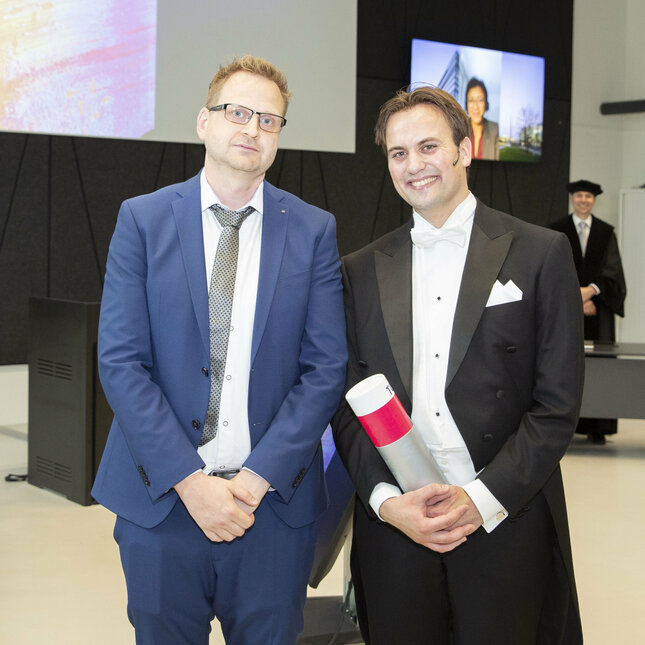How molecular structures move over time
Describing the nonadiabatic dynamics of molecular, spin-unpolarised systems

Molecular structures have interesting properties to model for many applications. Think for example of the OLED screen in your smartphone or television, and organic solar cells which are laid upon roofs. For these applications, one of the properties that are interesting for modeling is the dynamics of molecular structures: in short, how they move over time. Wouter Scharpach studied the initial-value problem associated with a class of time-dependent Kohn–Sham equations coupled with Newtonian nuclear dynamics, which describes the nonadiabatic dynamics of molecular, spin-unpolarised systems. He defended his thesis on June 21.
Atoms, which form the building blocks of molecular structures, consist of a nucleus, containing neutrons and protons, and a shell of electrons. Often the nucleus is far larger and heavier than the electrons, which cannot even be observed. Therefore, in many applications, classical dynamics (think of Newton's second law) are used to model the nuclei. The dynamics of the electrons is described by Schrödinger's equation, in which the electrons are depicted by an electronic wave function, depending on all the electronic positions. From this wave function, a probability distribution describing the probability that the electrons are encountered at specific positions at a specific time can be inferred.
High dimensionality of electronic wave function
Schrödinger's equation cannot be solved analytically except for a very simple case: this is why Scharpach had to resort to numerical programs on computers in order to obtain solutions. However, this is infeasible for the full Schrödinger equation: a single molecule of carbon dioxide, containing 22 electrons in total, would already need an incredible amount of storage (think of the order of ten to the power of forty in terms of the total amount of storage of this university). This is mainly due to the high dimensionality of the electronic wave function, as it depends on 66 spatial variables.

The key idea of density-functional theory, which has been developed to deal with this high-dimensionality problem, is that it can translate the single problem dealing with the high amount of electronic spatial degrees of freedom into multiple separate problems, which all deal with single-particle electronic wave functions, all depending on only three electronic spatial degrees of freedom. This way, Scharpach obtained feasibility of the systems of equations to solve. The downside, however, is that there is no explicit, closed form of these equations. To this end, a plethora of approximations has been developed, of which the time-dependent Kohn–Sham equations form one.
Validate the numerical solutions
Stitching all ingredients of the eventual system of equations to investigate together (the classical treatment of the nuclei together with the Kohn–Sham approximation of the electronic dynamics in the density-functional formulation, which dynamics are highly dependent on and therefore coupled with each other), the question arises whether this system actually has solutions, and whether these solutions are unique: in other words, whether this system is actually well-posed. With the answer to this question, one also can validate the numerical solutions obtained by the programs resorted to.
The coupled nature of the dynamics of the system, the nonlinear structure of the equations under investigation and the interdisciplinary nature of the project, requiring a physical as well as mathematical understanding of the problems at hand, all pose various challenges to overcome. The accomplishments in this project are formed by the formulation of conditions under which well-posedness results, as well as the formulation of the well-posedness theorems and their proofs themselves.
Title of PhD thesis: Well-posedness for time-dependent Kohn–Sham equations coupled with classical nuclear dynamics
Supervisors: dr. Björn Baumeier and dr. C. Mercuri
Media contact
Latest news
![[Translate to English:] [Translate to English:]](https://assets.w3.tue.nl/w/fileadmin/_processed_/9/4/csm_predatory_fe539af8af.jpg)


![[Translate to English:] Photo: Bart van Overbeeke](https://assets.w3.tue.nl/w/fileadmin/_processed_/e/0/csm_BvOF%202019_1031_BHF%20license%20TUe%20ILI%20copy_b6b93f2ef4.jpg)

